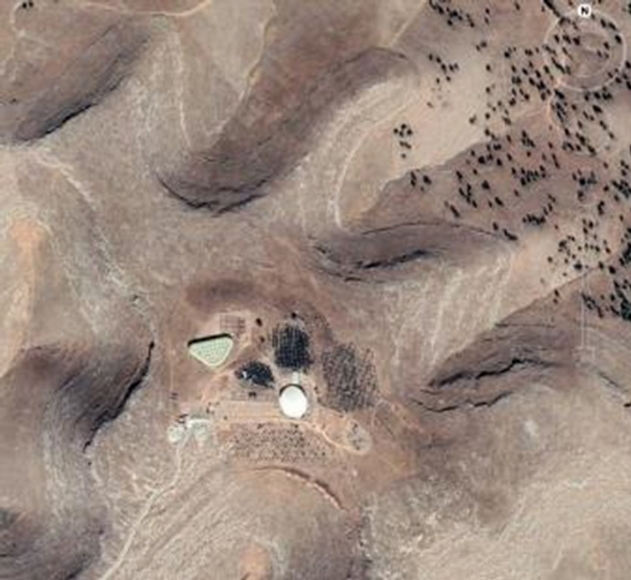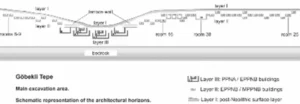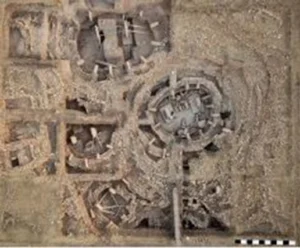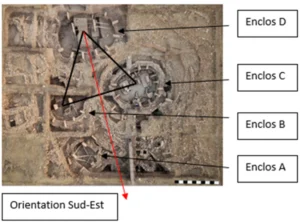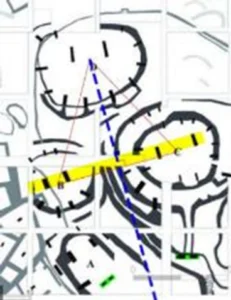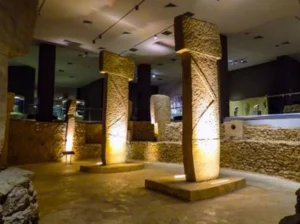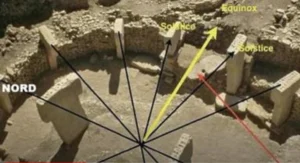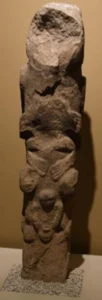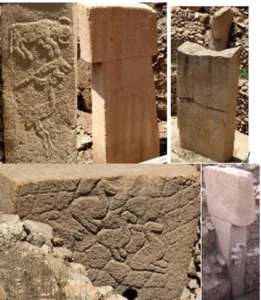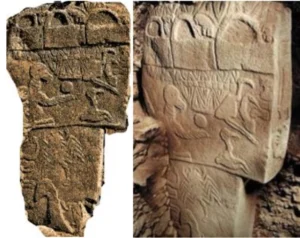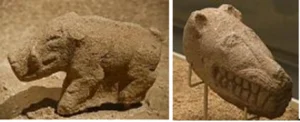Table of contents
PURPOSE OF THIS ARTICLE
As the title suggests, this article will summarize everything that has so far been discovered and said about this sacred site.
This article is not an explanation of the site. You’ll find it in a separate post, to follow, entitled:
GÖBEKLI TEPE : LA RÉSOLUTION DU MYSTÈRE
Before deciphering this site and its sacred raison d’être, I thought it would be useful, not to say necessary, to summarize everything that has been said and discovered about it by the world of archaeology. This will ensure that you know all the useful elements you need to memorize beforehand. All these elements will then be deciphered (in the article dedicated to deciphering this specific site), thanks to knowledge of the sacred prehistoric symbolic language, which, as you’ll see, will enable us to decipher the sacred meaning of each of these elements. As on all prehistoric sacred sites, this sacred symbolic language was abundantly used by the high priesthood to encode its teachings and doctrine, including its major doctrine: the rebirth of the father of the gods (deified primordial man) in the son-god through the mother-goddess (deified primordial woman) and her womb.
LINK THIS ARTICLE WITH THE ENTIRE LITERARY SERIES “THE TRUE HISTORY OF MANKIND’S RELIGIONS :
This article precedes the one devoted to explaining the mystery of the Stonehenge site, which you’ll find in a separate article on this site:
GÖBEKLI TEPE: THE MYSTERY SOLVED
or in the book entitled :
The megalithic temples of Malta, Göbekli Tepe and Stonehenge
which you can also find on sale in the following section:
Already published books
To find out why this book is part of the literary series The True Stories of Mankind’s Religions, go to page :
Introduction / Structure and Content
I hope you enjoy reading the full article below:
DATE FROM – 9 600 BC. J.-C. / GÖBEKLI TEPE IN TURKEY
SUMMARY OF INFORMATION AVAILABLE TO DATE FROM THE SITE
LOCATION
Göbekli Tepe is a prehistoric site occupied in the 10th and 9th millennia BC, Pre-Ceramic Neolithic A and B 1,2, located in the province of Şanlıurfa, Turkey, near the border with Syria, close to the town of Şanlıurfa.
The site of Göbekli Tepe covers about 9 hectares, measuring 300 meters in diameter. It culminates at 765 meters high, at the highest point of the Germuş Mountains that lie northeast of Şanlıurfa, located about 15 kilometers away.
https://fr.wikipedia.org/wik/Göbekli_Tepe
DESCRIPTION
Its occupation includes two levels.
Level III (c. 9,600-8,500 B.C.) comprises a group of megalithic structures located in the lower part of the site, “enclosures” 10 to 30 meters wide, in which T-shaped pillars sculpted with animal and human representations are erected. This represents a monumental achievement, unknown for this period.
The structures of Level II (c. 8,500 – 8,000 B.C.), excavated around the monumental area of the previous level on the slopes and summit of the mound, are rectangular in shape, smaller, and still have T-pillars, but in lesser numbers.
Göbekli Tepe is an atypical site for the time since it does not present any sure trace of houses and permanent domestic activities. There is also no indication that the communities that erected it practiced agriculture or animal husbandry. The site therefore does not witness the major developments associated with the dawn of the Neolithic, namely the domestication of plants and animals and the development of villages built by sedentary groups. On the other hand, it is a prime example of the mental developments accompanying these social and economic changes: its iconography reveals a rich symbolic universe, linked to the wild world, and its structures, of monumental type, are clearly places destined for the performance of rituals. This site is thus interpreted as a sanctuary serving as a gathering place for groups of hunter-gatherers living in the surrounding region, who meet there to hold community festivals.
https://fr.wikipedia.org/wik/Göbekli_Tepe
TURKISH ETYMOLOGY
Göbekli Tepe – means in Turkish ” belly hill “.
WK/Klaus Schmidt 2011 “Göbekli Tepe: A Neolithic Site in Southeastern Anatolia,” p. 138.
Some people also say the “navel hill”.
A MOUND SHAPED BY HUMAN HANDS
Mr. Schmidt says about it: This mound, this belly-shaped mound at the top of the limestone plateau this “navel hill” is not natural. It is a mound of 300 m by 300 m measuring 15 m in height
https://www.youtube.com/watch?v=6VKKIOb0ZpU.
DATATION
Göbekli Tepe was erected around the middle of the 10th millennium B.C., and ceased to be used after the first quarter of the 8th millennium B.C. In the chronology of the Near East, it thus takes place in the Neolithic known as “preceramic”, divided into two sub-periods, the Preceramic Neolithic A (or PPNA, c. 10,200-8,800 BC at the widest) and the Preceramic B (c. 10,000-8,000 BC at the widest).C. at its widest) and the Preceramic Neolithic B (or PPNB, c. 8,800-6,900 B.C.), following the terminology developed for the southern Levant at the site of Jericho, and also used for Southeastern Anatolia.
“… “the beginning of the excavations at Göbekli Tepe has brought to light the religious and symbolic aspect of the developments of the period. There is every reason to believe that this area around the Karaca Dağ mountain is one of the hotbeds of the Near Eastern Neolithic, an impression reinforced by the existence of other sites with spotted T-pillars that promise further discoveries of the same kind, Sefer Tepe not yet excavated and Karahan Tepe where excavations began in 2019.
https://fr.wikipedia.org/wik/Göbekli_Tepe
In this analysis, only this level, level III, will be discussed because it is the oldest:
Level III is the oldest level of the site, dated to the Preceramic Neolithic A and Early Preceramic Neolithic B, at the widest from 9,600-8,500 BC.
Note in passing the important point made about dating:
It should be noted that in general, for this site as for all archaeological sites, no current technique allows the dating of the size of a stone, and thus the direct determination of the period of construction of the site. Only by putting the objects found on the site back into their archaeological, historical and geographical context, through the style of the engraving, and by dating (in particular with carbon 14) any organic remains, can the hypothesis be made of a period
WK/(en) Oliver Dietrich, Çiğdem Köksal-Schmidt, Jens Notroff and Klaus Schmidt, “Establishing a Radiocarbon Sequence for Göbekli Tepe. State of Research and New Data,” Neo-Lithics, nos. 2013/1, 2013, pp. 36-41
STRATIGRAPHY
WK/See authors of the article (Dietrich L, Meister J, Dietrich O, Notroff J, Kiep J, Heeb J, et al.). – Dietrich L, Meister J, Dietrich O, Notroff J, Kiep J, Heeb J, et al. (2019) Cereal processing at Early Neolithic Göbekli Tepe, southeastern Turkey
(Note: on this stratigraphy there is an error with inversion between enclosure A and B)
LEVEL III EXCAVATIONS
WK/Aerial view of the main area of the excavation site. From bottom to top, circular enclosures A, B, C and D of level III/photo E. Kücük.
ENCLOSURES/FOCUS ON ENCLOSURES B, C AND D
On this site, as we shall see at Tara in Ireland, egg-shaped enclosures (notably C and D) are found side by side, within a larger structure, since we find enclosures that are perhaps of the same period as those determined to be the oldest, in this case C and D.
It is therefore difficult to say what the overall shape of the site must have been originally until the entire site has been excavated.
Note, however, that it has been suggested that B, C and D were the oldest and formed a triangle in the minds of the builders that can be represented very schematically, from the aerial photograph of the site, as follows:
Here is the documentary basis of the summary above:
This level includes a series of ovoid or circular structures delimited by enclosures and decorated with T-shaped pillars. Four were excavated during the first campaigns in the southeastern part of the site, in the lower zone, and named A to D in the order of their discovery. Subsequently, a fifth large structure, Structure H, was located and excavated in the central area. On the other hand, the structures of the same shape, but smaller to the west of this central space, F and G, are shallower and could date from more recent periods. Ground-penetrating radar survey of the site and geomagnetic analysis, which allowed for the identification of buried structures, indicated that at least fifteen such structures were found on this site, most of them not (yet) cleared. In fact, in test pits carried out on the site, which may have led to further excavations, other similar structures with T-pillars that could be dated to Level III were located.
Radiocarbon dates suggest that the structures in Level III were not erected and used at the same time, with Structures D and C in the central space apparently being the oldest, the former being erected around the middle of the tenth millennium BC. Structure A appears to be more recent, which is also indicated by its shape, which is less rounded than the preceding structures, bringing it closer to the smaller, rectangular structures of Level II. ” … ” These structures or enclosures are between 10 and 30 meters in diameter. ” … ” Structure D, which comprises the largest and best preserved enclosure, must have had 11 pillars originally, with the two central pillars rising to 5.5 meters high
https://fr.wikipedia.org/wik/Göbekli_Tepe.
It has been proposed, however, that structures B, C and D form a coherent whole built around the same period according to a geometric module thought out in advance, since if we connect their central points (at mid-distance between their central pillars), it forms a triangle with almost equal sides.
WK/Gil Haklay and Avi Gopher, ‘Geometry and Architectural Planning at Göbekli Tepe, Turkey’, Cambridge Archaeological Journal, vol. 30, no. 2, 2020, pp. 343-357
It is interesting that the Israeli researchers who noted the possibility of an equilateral triangle also noted that the center point of each enclosure is in the center and halfway between the central pillars.
Here is the report of another site with a more precise diagram indicating the location of the stones:
Researchers have discovered that Göbekli Tepe was built according to a very precise architectural plan: if one were to draw lines through the center points of three of these Neolithic structures (called enclosures), they would form an almost perfect equilateral triangle. Credits: Gil Haklay/AFTAU
https://trustmyscience.com/plus-ancien-temple-monde-construit-selon-grand-plan-geometrique/
FORMS OF THE ENCLOSURES
Structures C and D were found to consist of egg-shaped stone enclosures.
(Gobekli Tepe: a 6 th millenium BC monument/Dimitrios S. Dendrinos/15/11/2016 p.48)
PARTICULARITY OF THE ENCLOSURE C
It should be noted that enclosure C is different from the others in that it itself comprises several enclosures, its center is cut into the bedrock (which is also the case for D), with a narrow passage to access it, and with a U-shaped threshold to access it:
These structures are not all similar in their organization. Structure C in particular, which is larger, with a diameter of about 30 meters, comprises several concentric enclosures (three, perhaps four) delimited by pillars. Its central space is dug into the bedrock, the two central pillars being embedded in pedestals also cut into the rock. A narrow passage delimited by stone slab walls allowed access. Its entrance was marked by a U-shaped stone threshold, and steps had been carved into the rock in order to access it; this access was walled up at one time. The structure clearly underwent several reorganizations during the centuries of use: the outer enclosure is the oldest, the other two were added successively, each time reducing the interior space; this was accompanied by a displacement of the pillars towards the new enclosures; moreover, each of the enclosures underwent several construction phases (three for the first two, four for the last).
https://fr.wikipedia.org/wik/Göbekli_Tepe
T-SHAPED PILLARS
The enclosures are delimited by T-shaped pillars, between 10 and 12, and between 3 and 4 meters with stone walls of 2.5 m between them, probably so as not to be able to enter the circle other than through its main entrance.
2 pillars also in T, larger, 5,5 m, are systematically present in the center of each enclosure.
These pillars are extracted from the surrounding limestone plateaus.
The floor is cut into the rock for C and D.
These pillars are unquestionably anthropomorphic representations of humans.
Here is the documentary base of Wikipedia:
These generally include between 10 and 12 pillars in the shape of a T about 3 to 4 meters high, which delimit the edge. These pillars are connected to each other by stone walls about 2.5 meters high, some of them are provided, along their length, with a kind of bench. Two pillars are erected in their center, higher than the others, about 5.5 meters. These megaliths were extracted from the limestone plateaus surrounding the site, where quarries have been identified, one of which includes an unfinished pillar. The floor of this space is cut directly into the rock (enclosures C and D) or (probably for the later levels) paved with the terrazzo technique, using small stones. These constructions may have had a roof; it has been proposed that these enclosures were semi-buried, with access through the roofs, but there are no decisive arguments in this direction.
https://fr.wikipedia.org/wik/Göbekli_Tepe
The T-shape of the pillars is anthropomorphic: the body is represented by the shaft and the vertical top represents the head. This is confirmed by the fact that some of the central pillars include, in addition to animal representations, sculptures of arms, hands and loincloths.
The two central pillars clearly occupy a special place in the enclosures. Those of enclosure D are clearly representations of humans since they have arms and wear a belt, holding a piece of cloth that hides their genitals. The sex of these individuals cannot therefore be detected, and there is no clear indication of whether they represent a man or a woman ” .
WK/Klaus Schmidt, ‘Anatolia’, in Daniel T. Potts (ed.), A Companion to the Archaeology of the Ancient Near East, Malden and Oxford, Blackwell Publishers, coll. “Blackwell companions to the ancient world”, 2012 pp. 153-155.
Wikipedia/Cobija
Reproductions of the central pillars of Enclosure D in the Şanlıurfa Archaeological Museum; engravings depicting arms are visible on the shaft.
ORIENTATION
ALIGNMENT ON ORION
The site of National Geography reports the opinion of the British archaeologist Graham Philips for whom the central pillars of the sites are aligned on the three stars of the belt of the constellation of Orion, which have the characteristic that one of them is slightly shifted compared to the other two.
Graham Philip is convinced that the alignment of the two central pillars of each enclosure contains a hidden meaning. All the central pillars seem to face each other and face one direction. He discovered that these pillars appear to be facing north-northwest. Using software that allows him to go back in time to the site’s era and see the sky that was then visible at night. According to his program, the people of the time would have seen Orion’s belt rising on the horizon. Orion is one of the most recognizable constellations in the sky. It represents a man, with a club in one hand and a shield in the other. Orion is a hunter. Adrian also believes that the three pyramids depicted the three stars of Orion’s belt as a representation of the pharaoh’s flight into the stars
https://www.youtube.com/watch?v=wLK4iCswLKE.
ALIGNMENT OF THE DOORS ON THE EQUINOXES AND SOLSTICES
Other researchers, like Dimitrios S. Dendrinos, have come to the conclusion that structures C and D in particular are, by the arrangement of their central pillars, phased with the summer solstice.
He also adds: the sun’s rays would hit the pillars and orthostats of the northernmost structures of GT (from structure D and above) at sunrises between the spring and autumn equinoxes, but they would be blocked since the sunrises between the autumn and spring equinoxes (Gobekli Tepe: “a 6 th millennium BC monument”/Dimitrios S. Dendrinos/15/11/2016 p.9)
ORIENTATION IN CONNECTION WITH THE SOLSTICE
The width/depth/height ratios of the stones and the direction of the width of the monoliths in conjunction with their locations were not random. They not only obeyed rules, but they also had an abstract symbolic meaning for the architect of the monumental structure. They were placed and oriented in such a way that they interacted both in an intrastructural and inter-structural manner. The megaliths not only define the enclosure, but they also define the connections between the enclosures. Of course, these connections go far beyond mere symbolism, which is not a topic of this article, but determines the architecture and engineering criteria of the monument – dimensions, proportions, spacing, etc. (Gobekli Tepe: a 6 th millennium BC monument/Dimitrios S. Dendrinos/15/11/2016 p.43)
The orientations of both structures C and D and their monoliths were analyzed. These structures were found to have both apparent (based on the point of entry) and true orientations, the latter being their axis of symmetry from the floor plan of the stone enclosures. The actual orientations indicate a relationship to sunrise during the summer solstice.
(Gobekli Tepe: a 6 th millennium BC monument/Dimitrios S. Dendrinos/15/11/2016 p.49)
The two central pillars of all enclosures appear to be oriented in a manner generally parallel to the apparent general orientation of the enclosure “…” This is not the intended orientation of structure C or D; the actual orientation of structure C is toward the rising sun of the summer solstice, as is the approximate actual orientation (axis of symmetry) for structure D. (Gobekli Tepe: a 6 th millennium BC monument/Dimitrios S. Dendrinos/15/11/2016 p.21)
A similar explanation can be found on the Arcana site:
Arcana website
APPARENT MALE-FEMALE SYMBOLISM BETWEEN THE TWO CENTRAL PILLARS
Mr. Dendrinos also notes a slight gap between one and the other central pillar and that they seem to follow each other; while noting a symbolic dichotomy man-woman that must represent according to him the dual aspect of these pillars.
If you look closely at the two central pillars of all the enclosures, you can see that the two megaliths are never exactly parallel to each other, and they don’t line up exactly to be level on their narrow sides – they are placed as if one pillar slightly, but unobtrusively, “follows” the other. ” … ” Since this article does not deal with symbolism per se, any interpretation that may be drawn from the placement, relative dimensions, orientations, etc. of these stones is left to the interested reader. Obviously, symbolism is also attached to the number of monoliths embedded in each structure, beyond perhaps a male-female (deity/ancestral) dichotomy represented by the two central pillars.
Göbekli Tepe: a 6 th millennium BC monument/Dimitrios S. Dendrinos/15/11/2016 p.22)
ORIENTATION WITH SHADOW CHOREOGRAPHY
Moreover, Mr. Dendrinos thinks that the builders consciously sought a symbolism of shadows by making sure that by day and by night, the shadows of the central pillars are reflected according to a particular symbolism on the pillars of the enclosure, as well as between them. It evokes again an allegory man-woman foreseen by the builders. He envisages in particular for the enclosure D the possibility of a sundial, this enclosure containing 12 orthostats.
All the orthostats uncovered so far seem to have an orientation in the general direction toward the central space of the enclosure, but they are not always and exactly oriented toward a fixed central point. It seems that the architect wanted to have different shading conditions on them, as well as orientation.
” … ” In addition, these stones have been placed at specific points to interact to the extent that their shadows are involved, during sunny days and moonlit nights. In the movements of their shadows, the interactions occur both day and night. ” … “
From all of Figures 2.2 through 5.4 and given the orientation, height, width, depth, and location of the T-shaped monoliths within each structure, it is evident that certain choreography was staged within each structure, and a male-female allegory was planned. The shadows of the two pillars at the center of these structures in their daily movements leaned, reflected on the different orthostats at specific times of the day, and on each other. This role, in combination with the art on the pillars and orthostats, was part of a decision that influenced their specific location and orientation. It is highly likely that the interaction of the shadows was intended to convey some symbolism. (Gobekli Tepe: a 6 th millenium BC monument/Dimitrios S. Dendrinos/15/11/2016 p.43)
In the particular case of Structure D, with the twelve orthostats drawn into the wall enclosure masonry, this may suggest that a hexadecimal daily clock system was in effect, with the shadows of specific orthostats during the day indicating a specific time of day. An accurate drawing (possibly by scanning) of these orthostats and their exact orientation might offer the possibility to test this suggestion. (Gobekli Tepe: a 6 th millenium BC monument/Dimitrios S. Dendrinos/15/11/2016 p.45)
The shadows of the central pillars and orthostats cast in the enclosures were seen as a means of integrating symbolic choreography, and perhaps as part of a complex sundial-like mechanism based on the hexadecimal system implemented in the stone enclosure structures. The hexadecimal system is largely based on the twelve orthostats of structure D. (Gobekli Tepe: a 6 th millennium BC monument / Dimitrios S. Dendrinos/15/11/2016 p.49).
STONE OF PASSAGE
We find passage stones located in symbolic places such as the doors and windows of the enclosures. Their function remains mysterious.
One of them is a totem of 1m90 whose explanation is also mysterious.
Site Arcana/https://www.youtube.com/watch?v=6EIZYWwSZAs
Here it is (Wikipedia image)
Please read the following description by its author, Mr. Dosseman:
This object is described in an issue of Actual Archaeology of Summer 2012. “… “It is 1.92 meters tall and has three main patterns on top of each other.
The upper part represents a predator, probably a bear or a large felid. The frontal part of the head had been obliterated in antiquity; the surface of the break is covered with a thin limestone coating. Under the head, a short neck, arms and hands are visible. Their human form is remarkable. Although it can be postulated that this was a human-animal hybrid, it can also be considered a whole animal. The arms (or legs) hold another head that has still lost its face in antiquity. The motif of a wild beast holding a human head is well known from several sculptures from Nevali Çori and Göbekli tepe. For this reason, it is very likely that the lost face was that of a human, further reinforced by the fact that human arms are represented under the head. The hands are placed opposite each other and on the belly of the individual, a manner reminiscent of the T-shaped pillars.
Under the arms and hands is visible a second person whose face has been preserved. The upper part of the body, including the arms and hands, is also represented. Under the hands is an unidentified object. It seems likely that the person is depicted in labor, although she may also have a phallus. On both sides of the pole, large snakes are visible, their heads just above the level of the small individual. Beneath the snakes’ heads are visible structures that can be interpreted as the legs of the taller human. Fragments of a similar totem-shaped object had been discovered 20 years earlier at Nevali Çori. From an illustration on WikiCommons, “Totem from Göbekli Tepe, Layer II, 8,800-8,000 BCE Sanliurfa Museum”.
ICONOGRAPHY OF THE PILLARS
Many of these pillars are carved, usually in low relief, sometimes in high relief. The most common representations are of animals: snakes, foxes and boars above all, but also aurochs, gazelles, mouflons, onagers, cranes, ducks and vultures. Whenever identifiable, the gender of these animals is male, and they are repeatedly depicted in an aggressive posture.
The representations also include abstract symbols, especially an H-shaped symbol, straight or lying down, as well as crescents and discs, and opposite signs. Carved human representations are rare; Pillar 43 in Enclosure D appears to depict a headless, ithyphallic man in the lower right. ” … “
Figure from left to right and top to bottom:
Pillar 2 of pen A: auroch, fox and crane
Pillar 10 of pen B: fox.
Pillar 12 of pen C: birds.
Pillar 27 of enclosure C: predator (feline?) crouching in high relief.
Pillar 37 (central) of enclosure C: fox.
Pillar 43 of enclosure D: vulture and scorpion
Wikipedia/Photos by Klaus-Peter Simon
OTHER CARVED OBJECTS
The structures of Göbekli Tepe, levels I and II, have moreover delivered several small sculptures on stone, which it is generally impossible to attribute to one period or another. The iconographic repertoire is again very rich, and similar to that of the pillars of level III, with mainly animal representations, but also human, and once again essentially masculine
Boar sculpture
Threatening animal mouth
MATERIAL CULTURE
” … ” The heavy polished stone furniture used for grinding is highly standardized: large basalt mortars of ovoid shape, accompanied by cylindrical or conical pestles also produced from basalt. Large limestone containers were also found, as well as limestone slabs with marks in the form of small cups and large limestone rings 0.5 to 1 meter in diameter whose function could not be identified.
WK/Klaus Schmidt, “Göbekli Tepe: A Neolithic Site in Southeastern Anatolia,” in Sharon R. Steadman and Gregory McMahon (eds.), Handbook of ancient Anatolia (10,000 – 323 B.C.E.), Oxford, Oxford University Press, 2011. P.918, 919)
SUBSISTANCE
” … ” The objects and installations related to food brought to light at Göbekli Tepe are atypical in the context of this period. The site did not indeed yield any hearths or ovens, nor any silos, but on the other hand its two levels include an unusually high concentration of instruments for grinding grain. Similarly, tools related to hunting are very present, as well as animal remains (above all gazelles, aurochs and hemiones).
WK/Joris Peters and Klaus Schmidt, “Animals in the symbolic world of Pre-Pottery Neolithic Göbekli Tepe, south-eastern Turkey: a preliminary assessment,” Anthropozoologica, vol. 39 “Animal domestications: social and symbolic dimensions. Tributes to Jacques Cauvin, Villeurbanne, 21-23 November 2002′, no 1, 2004/p. 182-183 and 206-208
There are also numerous fragments of stone drinking cups. There is no water source near the site, cisterns have been found on the limestone plateau above it, but their capacity is 153 m3, which is considered too limited to supply a village with water. All of this suggests that the site is not permanently populated and is only used for occasional, festive events, leading to significant seasonal peaks in consumption, which require a large production of food, and apparently also of fermented beverages.
INTERPRETATIONS
I leave it to you to go and read on the site or elsewhere to take note in detail of the classical interpretation of this site of Göbekli Tepe. It is an interpretation that I cannot take the time to relate and still to comment and which is supported by the majority of the experts of the site. It turns roughly around the classic and hackneyed scientistic idea of a people of hunter-gatherers who, by settling down, would have undertaken here a cult of agricultural and breeding nature (requiring the domestication of the animal world) and thus marking a turning point in their community evolution (sic).
Let’s just remember what is the most important and what (almost! because some people still see it as a purely domestic and not religious use!) “everyone” seems to agree on:
It is a sanctuary, a sacred site.
This is already a starting point! We are making progress! :
The interpretation of Göbekli Tepe by Klaus Schmidt and his excavation team, formulated as soon as it was uncovered and valid for both Level III and II, is that the structures uncovered are sanctuaries, without the presence of domestic spaces, and even the “first temples” known. They would serve within the framework of a cult grouping several groups of hunter-gatherers, on a “supra-regional” scale
https://fr.wikipedia.org/wik/Göbekli_Tepe.
ICONOGRAPHY, BELIEFS AND RITUAL PRACTICES
Today, as I write these lines[1] , and before reading the explanation to come, what understanding do we have of this site? :
The analysis of the T-pillars and their iconography is seen as the key to understanding the mental and ritual universe of this community, but it can only be conjectural, since the parallels drawn concern either historical periods in the same region, very much posterior to that of the site’s activity, or ethnographic parallels coming from other places and times. Schmidt wants to see the figures represented by the pillars as “supernatural beings”, while the other, smaller anthropomorphic representations unearthed at the site or others from the same periods (Nevalı Çori) would be some kind of “guardians of the other world”, of lower status. According to this interpretation, the enclosures “symbolize human assemblies, and the standing stones, arranged in a circle, represent stylized figures.
https://fr.wikipedia.org/wik/Göbekli_Tepe.
We also find this interpretation: “allegorically, in the center, the gods without faces, surrounded by their pantheon of animal deities”.
Site Arcana/https://www.youtube.com/watch?v=6EIZYWwSZAs
Concerning the animals represented, they correspond to the fauna that was then found around the site and that was hunted, even if the animals that were most often on the menu of the festivals of Göbekli Tepe (gazelles, bovids, hemiones) are not those that are most represented (snakes, foxes, boars). This inadequacy suggests that these representations refer rather to mythological motifs than to rituals related to hunting. The fact that they are often represented in an aggressive posture could indicate that they serve as protectors for the anthropomorphic pillars, but this option is not necessarily sufficient, because the engraved symbolic message seems more complex, especially because animal motifs coexist with others that are not. The representations of vultures could refer to the theme of death, the site having perhaps been used for funeral rites. The snake is commonly represented on sites of the period (on dishes and engraved plates). The common presence of the fox is more difficult to interpret, as this animal does not appear much in the Near Eastern iconographic repertoire afterwards. Differences have also been noted between the enclosures of level III: the snake is more represented in structure A, the fox in B, the boar in C, while D presents a more varied imagery, where birds (vultures in particular) occupy an important place, and in H the felines seem more present. As seen above, these could be “totemic” animals serving as emblems for the different groups sharing the site73, 74, 45.
https://fr.wikipedia.org/wik/Göbekli_Tepe
Some of the megaliths at Göbekli Tepe, which can be up to 5.5 meters high and weigh up to 50 tons (45 metric tons), are naked, while others are covered with impressive carvings of abstract symbols and animals such as foxes, lions, bulls, snakes and insects.
“…” “Each area appears to have a dominant animal that was represented multiple times,” Carter said. This could mean that different groups of hunter-gatherers (each with their own representative animal) could have been present. Scientists believe that hunter-gatherers were largely animists (?? Sic) (believing that everything from animals to plants had a spirit). “In animist cultures, representations of animals are usually linked to specific cultural groups,” he said. But the largest of the enclosures, called Enclosure D, “has a wide variety of animal representations,” he added.
https://trustmyscience.com/plus-ancien-temple-monde-construit-selon-grand-plan-geometrique/
Comparing the data from Göbekli Tepe and the later Neolithic site of Çatal Höyük in Central Anatolia (c. 7,400-6,000 B.C.), I. Hodder and L. Meskell proposed to identify three main symbolic themes:
- the emphasis on penises in the iconography, a phallocentric aspect of the cult, which goes against the widespread idea of the importance of a fertility cult linked to a “great goddess” during the Near Eastern Neolithic
- the emphasis on wild and dangerous animals, as implied by the dominant presence of predators, often in a threatening posture, with claws and fangs clearly underlined, in the iconographic repertoire of Göbekli Tepe (more than at Çatal Höyük)
- practices of piercing and handling bodies, including the removal of skulls from both humans and animals.
All this symbolism and the rituals linked to it would have a memorial and historical dimension, visible in the continuity of occupation and the different phases of reconstruction of these sites. The control of the wild world and the manipulation of the bodies would take part in the changes accompanying the installation of the process of domestication (?? sic).
https://fr.wikipedia.org/wik/Göbekli_Tepe
The association between human-shaped pillars and animal representations (particularly on pillar 43 of enclosure D, the richest from an iconographic point of view), combined with the analysis of other artistic representations from the same period, could also be interpreted as referring to shamanistic practices (?? sic).
Representations of headless humans and fragments of skulls found at Göbekli Tepe indicate that a “cult of skulls” (commonly interpreted as a form of ancestral worship) was practiced there, as in several sites in the Levant of the same period. Nevertheless, these skulls present specificities not attested elsewhere: deep incisions, which seem to indicate a form of decoration unknown elsewhere. It is therefore a new variation of this type of cult.
https://fr.wikipedia.org/wik/Göbekli_Tepe
Concerning the cult of the skulls, according to the researchers of the site, the skulls were decorated, pierced at the top and tied with strings. Then it is likely that they were hung up for all to see. The ancestors occupied a primordial place. At that time, skulls played a crucial role in the ritual beliefs of this people.
https://www.youtube.com/watch?v=wLK4iCswLKE
REASONS FOR THE BURIAL OF THE SITE
The burial of the monuments was done in haste and was probably started with a benevolent will to protect; it ended with a probably malicious action at the end of the Neolithic and just before the beginning of the Bronze Age. (Gobekli Tepe: a 6 th millenium BC monument/Dimitrios S. Dendrinos/15/11/2016 p.49)
[1] July 2021
BIBLIOGRAPHY
— https://fr.wikipedia.org/wik/Göbekli_Tepe.
— WK/Klaus Schmidt 2011 « Göbekli Tepe : A Neolithic Site in Southeastern Anatolia ».
— https://www.youtube.com/watch?v=6VKKIOb0ZpU.
— Oliver Dietrich, Çiğdem Köksal-Schmidt, Jens Notroff et Klaus Schmidt, « Establishing a Radiocarbon Sequence for Göbekli Tepe. State of Research and New Data », Neo-Lithics, nos 2013/1, 2013.
— See authors of the article (Dietrich L, Meister J, Dietrich O, Notroff J, Kiep J, Heeb J, et al.). — Dietrich L, Meister J, Dietrich O, Notroff J, Kiep J, Heeb J, et al. (2019) Cereal processing at Early Neolithic Göbekli Tepe, southeastern Turkey.
— https://trustmyscience.com/plus-ancien-temple-monde-construit-selon-grand-plan-geometrique/
— Gobekli Tepe: a 6 th millenium BC monument/Dimitrios S. Dendrinos. 15/11/2016.
— Klaus Schmidt, ‘Anatolia’, dans Daniel T. Potts (dir.), A Companion to the Archaeology of the Ancient Near East, Malden et Oxford, Blackwell Publishers, coll. « Blackwell companions to the ancient world », 2012.
— https://www.youtube.com/watch?v=wLK4iCswLKE.
— SiteArcana : https://www.youtube.com/watch?v=6EIZYWwSZAs
— Actual Archaeology. Summer 2012
— Klaus Schmidt, « Göbekli Tepe: A Neolithic Site in Southeastern Anatolia », dans Sharon R. Steadman et Gregory McMahon (dir.), Handbook of ancient Anatolia (10 000 – 323 B.C.E.), Oxford, Oxford University Press, 2011. P.918, 919)
— Joris Peters et Klaus Schmidt, « Animals in the symbolic world of Pre-Pottery Neolithic Göbekli Tepe, south-eastern Turkey: a preliminary assessment », Anthropozoologica, vol. 39 « Domestications animales: dimensions sociales et symboliques. Hommages à Jacques Cauvin, Villeurbanne, 21-23 novembre 2002’, no 1, 2004/p. 182-183 et 206-208
— https://www.youtube.com/watch?v=wLK4iCswLK
REMINDER OF THE LINK BETWEEN THIS ARTICLE AND THE ENTIRE LITERARY SERIES “THE TRUE HISTORY OF MANKIND’S RELIGIONS”:
This article precedes the one devoted to explaining the mystery of the Stonehenge site, which you’ll find in a separate article on this site:
GÖBEKLI TEPE: THE MYSTERY SOLVED
or in the book entitled :
The megalithic temples of Malta, Göbekli Tepe and Stonehenge
which you can also find on sale in the following section:
Already published books
To find out why this book is part of the literary series The True Stories of Mankind’s Religions, go to page :
Introduction / Structure and Content
COPYRIGHT REMINDER
As a reminder, please respect copyright, as this book has been registered.
©YVAR BREGEANT, 2021 All rights reserved
The French Intellectual Property Code prohibits copies or reproductions for collective use.
Any representation or reproduction in whole or in part by any process whatsoever without the consent of the author or his successors is unlawful and constitutes an infringement punishable by articles L335-2 et seq. of the French Intellectual Property Code.
See the explanation at the top of the section on the author’s policy for making his books available:
Already published books
